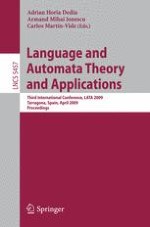2009 | Buch
Language and Automata Theory and Applications
Third International Conference, LATA 2009, Tarragona, Spain, April 2-8, 2009. Proceedings
herausgegeben von: Adrian Horia Dediu, Armand Mihai Ionescu, Carlos Martín-Vide
Verlag: Springer Berlin Heidelberg
Buchreihe : Lecture Notes in Computer Science
